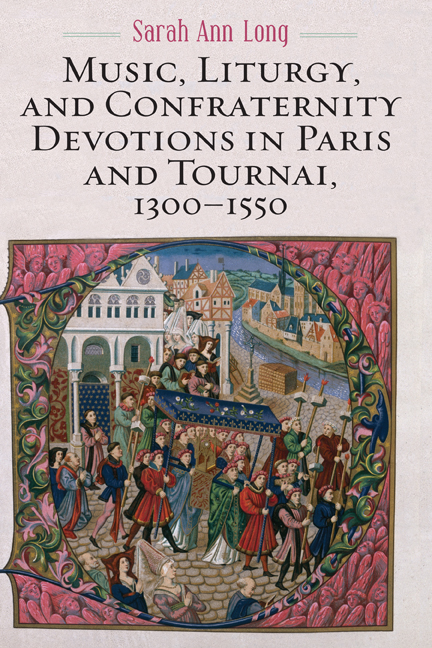Book contents
- Frontmatter
- Dedication
- Contents
- List of Illustrations
- Acknowledgments
- List of Abbreviations
- Editorial Procedures for Foreign Languages and Music Examples
- Note on Online Material
- Introduction
- 1 Confraternities and Popular Devotions to St. Barbara in Tournai
- 2 Relic Translation and Healing in Liturgies for St. Catherine and St. Nicholas in Paris
- 3 Historical Narratives and the Importance of Place in Masses for St. Sebastian
- 4 Compositional Practice, Networks, and the Dissemination of the Mass Ordinary in Confraternity Sources
- 5 The Role of the Parisian Book Production Community in the Perpetuation of Popular Devotions
- Conclusion
- Appendix 1 Sources
- Appendix 2 Inventories of Sources from Tournai
- Appendix 3 Scribal Hands and Gatherings in the Tournai Notary Confraternity Manuscripts
- Notes
- Bibliography
- Index of Chant and Polyphonic Compositions
- Index of Early Printed Liturgical Books
- Index of Manuscripts
- General Index
2 - Relic Translation and Healing in Liturgies for St. Catherine and St. Nicholas in Paris
Published online by Cambridge University Press: 23 June 2021
- Frontmatter
- Dedication
- Contents
- List of Illustrations
- Acknowledgments
- List of Abbreviations
- Editorial Procedures for Foreign Languages and Music Examples
- Note on Online Material
- Introduction
- 1 Confraternities and Popular Devotions to St. Barbara in Tournai
- 2 Relic Translation and Healing in Liturgies for St. Catherine and St. Nicholas in Paris
- 3 Historical Narratives and the Importance of Place in Masses for St. Sebastian
- 4 Compositional Practice, Networks, and the Dissemination of the Mass Ordinary in Confraternity Sources
- 5 The Role of the Parisian Book Production Community in the Perpetuation of Popular Devotions
- Conclusion
- Appendix 1 Sources
- Appendix 2 Inventories of Sources from Tournai
- Appendix 3 Scribal Hands and Gatherings in the Tournai Notary Confraternity Manuscripts
- Notes
- Bibliography
- Index of Chant and Polyphonic Compositions
- Index of Early Printed Liturgical Books
- Index of Manuscripts
- General Index
Summary
Alleluya. O Nicholas, your tomb drips oil, of which a small stream preserves the care of the sick; protect the present from fevers that cause a death that is everlasting.
St. Nicholas, a bishop of Myra in the fourth century, captured the imaginations of many writers and composers from the high Middle Ages through the Renaissance. This alleluia verse appears as part of the Mass for St. Nicholas in two confraternity manuscripts from northern France: Paris, Bibliothèque Mazarine MS 464 (F-Pm 464), for the Confraternity of the Spice Dealers and Apothecaries in Paris; and B-Tc A 13, for the Confraternity of the Notaries at the Tournai cathedral (see chapter 1). The text calls upon him for protection from “fevers that cause a death that is everlasting,” a reference to the plague, which was seen as God's wrath on earth. It also alludes to one of his most celebrated virtues, as St. Nicholas was, according to legend, a myroblyte, whose relics were believed to secrete a holy oil, or myrrh, with healing attributes. For this reason, his popularity grew in Western Europe after the theft of his relics from Myra and their relocation to Bari in 1087. From this point on, St. Nicholas became one of the most widely venerated saints of the Catholic Church, and his feast was normally celebrated at the high rank of duplex in cathedrals and parishes in northern France. He also assumed an important role in devotions among the laity, becoming the subject of miracle plays and the patron saint of countless groups of people, including students and scholars, children, those seeking to become pregnant, merchants, and sailors. This resulted in the hundreds of devotional and trade confraternities adopting St. Nicholas as their patron, making these communities a driving force in the creation of new music and text in his honor.
In this chapter, I explore new masses and offices focused on healing narratives for the Translation of the Relics of St. Nicholas and the Finding of the Relics of St. Catherine of Alexandria, which appear exclusively in Parisian confraternity manuscripts.
- Type
- Chapter
- Information
- Publisher: Boydell & BrewerPrint publication year: 2021

